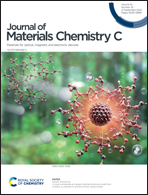Triplet–triplet annihilation upconversion combined with afterglow phosphors for multi-dimensional anti-counterfeiting and encoding†
Abstract
Traditional anti-counterfeit luminescent materials were limited by the fixed excitation and emission mode. Complex anti-counterfeiting strategies with multiple luminescent modes are significantly required for defeating the continuously developing counterfeit technologies. In this work, triplet–triplet annihilation upconversion (TTA-UC) materials were applied for anti-counterfeiting and encoding by combining with lanthanide-doped afterglow phosphors through an energy transfer process. This combination constructed a multi-mode luminescent system with four different luminescent modes, and the corresponding multi-dimensional anti-counterfeiting patterns were prepared by a direct-writing method. A dual polymer network matrix consisting of poly-α-pinene (PαP) and polyisobutylene (PIB) could protect TTA-UC from oxygen quenching and improve the printability of the system. Based on the four luminescent modes, multiple information could be obtained from the anti-counterfeit patterns and encoding arrays. This work provides a new perspective for designing multi-dimensional anti-counterfeiting and encoding methods with high information concealment and security.



 Please wait while we load your content...
Please wait while we load your content...